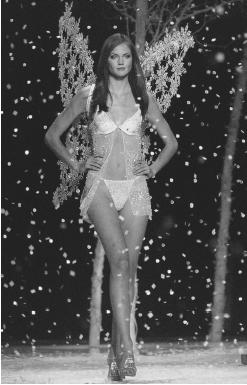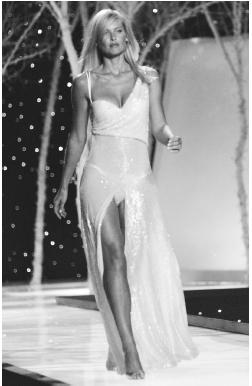Victoria's Secret - Fashion Designer Encyclopedia
American Intimate apparel and accessories for women
Founded: by Roy Raymond in 1977, in San Francisco. Company History: Published first catalogue, 1978; sold for $4 million to The Limited apparel group, 1982; Cacique sibling formed to market French-styled lingerie, 1988; introduced swimwear, 1991; began selling cotton panties, 1993; launched bath and body line and introduced Miracle Bra, 1994; first runway show, 1995; spun off by The Limited, 1995; introduced seamless bras, 1996; launched legwear, 1998; went online with firm website, 1998; first live web fashion show, 1999; debuted Dream Angels fragrance collection, 1999; sponsored AIDS fundraiser with Miramax Films, 2000; launched first men's fragrance collection, 2001; launched Pink fragrance and aired first television fashion show, 2001; signed license with Shiseido Company Ltd. for cosmetics, 2001. Company Address: 3 Limited Parkway, Columbus, OH 43216, U.S.A. Company Website: www.VictoriasSecret.com .

Publications
On VICTORIA'S SECRET:
Articles
Perman, Stacy, "Victoria's Secret Hitting the Beach," in WWD, 30 March 1994.
Belcove, Julie L., "Victoria's Secret—Boudoir to Bath with July Entry," in WWD, 6 May 1994.
Moin, David, "The Intimate Category Killer," in WWD, 13 March 1995.
Machan, Dyan, "Sharing Victoria's Secrets," in Forbes, 5 June 1995.
Brady, Jennifer L., "Victoria's Secret Seamless Bra Sews Up Sales," in WWD, 16 September 1996.
Palmieri, Christopher, "Victoria's Little Secret," in Forbes, 24 August 1998.
Moin, David, and Laura Kelpacki, "Victoria's Secret Puts Sex Appeal and Color into Cosmetics Line," in WWD, 18 September 1998.
Napoli, Lisa, "Bared-Bones Fashions, Fully Covered Publicity," in the International Herald Tribune, 11 February 1999.
Moin, David, and Pete Born, "IBI Giving Victoria's Secret Push Into Global Prominence," in WWD, 29 September 1999.
"Victoria's Secret to Cosponsor AIDS Benefit," in WWD, 9 February 2000.
Hickins, Michael, "Victoria's Secret Shifts Into Global Overdrive," in WWD, 5 April 2000.
Klepacki, Laura, "Victoria's Secret Takes a Brave Step," in WWD, 27 January 2001.
Born, Pete, "Victoria's Secret's New Interest: Guys," in WWD, 12 October 2001.
"Victoria's Secret Launches Something Very Sexy for Him," in Cosmetics International, November 2001.
"FCC Fields Complaints About Victoria's Secret Show," in Adweek, 19 November 2001.
***
Victoria's Secret made buying lingerie not only a pleasure but a must in the late 1980s and 1990s. The upscale lingerie and apparel


Men gladly accompanied their wives or lovers to Victoria's Secret, while women enjoyed finding a myriad of products in every size and shape imaginable. This was the experience Roy Raymond had in mind when he founded Victoria's Secret in 1977 in San Francisco. Loath to shop for lingerie or foundations for his wife in austere surroundings, Raymond envisioned an appealing shop with a stylish decor—somewhere with a Victorian-boudoir feel. The next year, Raymond took his lingerie fantasies a step further, creating a mail order catalogue to sell his growing selection of bras, panties, slips, and loungewear.
The response to the Victoria's Secret catalogue was immediate and stunning; Raymond's business mushroomed in size and scope yet he had problems meeting demand and running the mail order business. While there were rivals, such as Frederick's of Hollywood which sold many of the same products, Frederick's had a raunchy feel to its stores and looked more like an S&M supplier than intimate apparel retailer. In 1982, Raymond sold the company, which consisted of six faltering stores and its catalogue, for $4 million to Leslie Wexner, founder of The Limited women's apparel firm.
Throughout the remainder of the 1980s, the Victoria's Secret mystique grew and Wexner decided to add another lingerie maker to his fold, launching Cacique as a French counterpart to Victoria's faux English styling. While Cacique stores opened near or by Victoria's Secret stores in 1988 and 1989, the older sibling's catalogues had reached the pinnacle of popularity. The thick magazine-like editions became acceptable "girlie" material for men of all ages. Women awaited the arrival of catalogues almost as eagerly as men; soon the pages were crowded with not only intimate apparel but sportswear and accessories as well. Gone were the posed couples that had populated Raymond's catalogue, replaced by sexy, pouty, internationally known models. Being selected to pose for a Victoria's Secret catalogue became a much sought after job, a stepping stone to model superstardom.
In the early 1990s Victoria's Secret continued to broaden its product line with swimsuits (and a special swimwear catalogue reminiscent of the annual Sports Illustrated edition), simple, cotton panties—which suddenly made the old-fashioned underwear hip and must-have—and a bath and body line called Second Skin Satin Luxury Bath Collection. Next came the Miracle Bra in 1994, released months ahead of Warner's Wonderbra. The Limited, which had created a subsidiary called Intimate Brands to manage Victoria's Secret and its sister company, Bath & Body Works, spun the company off in 1995, retaining a majority stake when the firm went public.
Despite its similarity to its sibling, Cacique failed to gain the notoriety or clientéle of its much famed elder. Intimate Brands closed the chain in 1998, putting a new home furnishings concept into many of the stores called the White Barn Candle Company. Around the same time, Victoria's Secret introduced cosmetics into its stores and catalogue, setting the stage for Victoria's Secret Beauty, which began as in-store shops. The firm then joined the wave of the future by launching a company website. Although many retailers had websites for information, store locations, and to sell products, Victoria's Secret decided to broadcast its spring fashion show live via the Internet in early 1999. Servers were completely unprepared for the 1.5 million viewers who tried to log on; they were not only completely overwhelmed by the response but jammed for hours and eventually crashed due to the unexpected crush of web surfers.
In 1999 parent company Intimate Brands introduced additional cosmetics to Bath & Body Works and Victoria's Secret stores, and took the in-store Victoria's Beauty shops and started creating separate stores either adjacent to or near existing Victoria's Secret boutiques. Over the next two years, the company moved in several new directions. A men's fragrance collection, called Very Sexy for Him, was developed for a 2001 launch while the firm entered talks with Japan's Shiseido Company Ltd. to create a cosmetics line. Additionally, after the success of its website fashion show, Victoria's Secret raised the bar and took its spin on fashion to prime-time television. Its first-ever televised fashion show, aired by ABC in November, stirred controversy when concerned viewers complained to the Federal Communications Commission (FCC) about the "indecency" of the scantily clad models. Fortunately for Victoria's Secret, neither the FCC nor most of viewing public found the showing indecent. On the contrary, millions tuned in and enjoyed the provocative parade.
By 2002 there were about 2,300 Victoria's Secret boutiques in the U.S., and its racy and lacy catalogues were mailed to more than 350 million households annually. Its stores had become as much about attitude and indulgence as undergarment needs—women loved the sexy, ultrafeminine innerwear, and it made them feel sexy and beautiful regardless of their age, size, or inclination.
—Nelly Rhodes
Comment about this article, ask questions, or add new information about this topic: